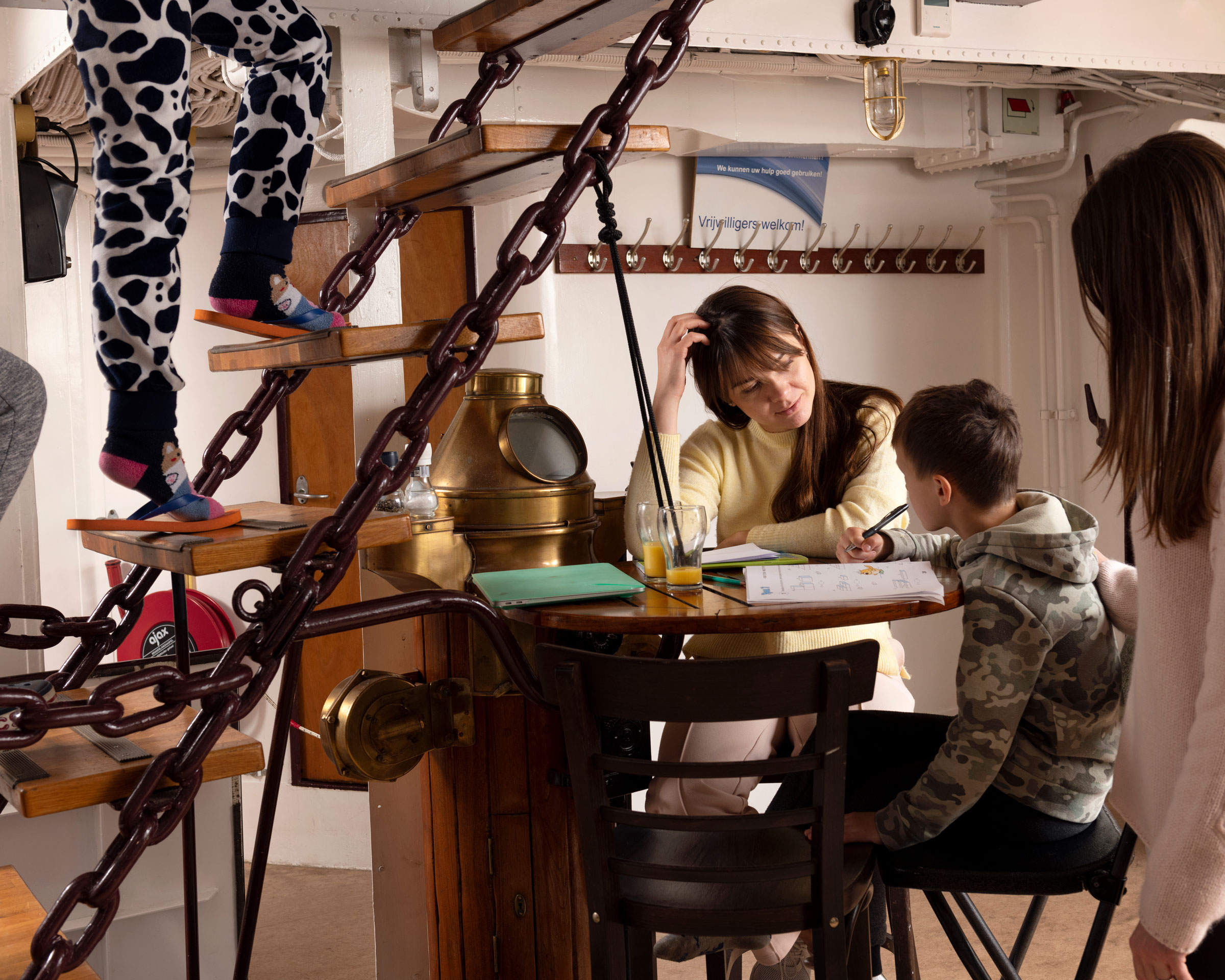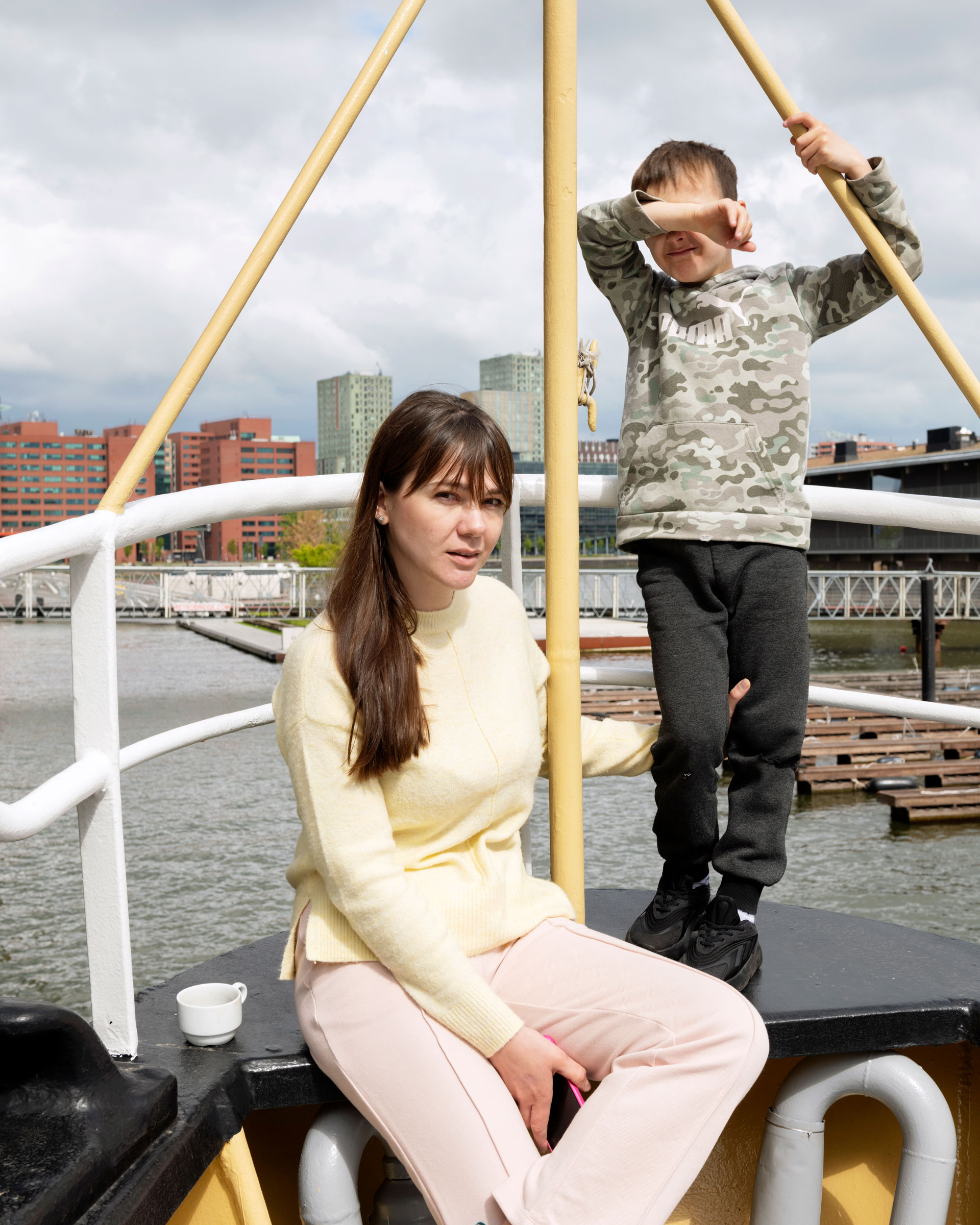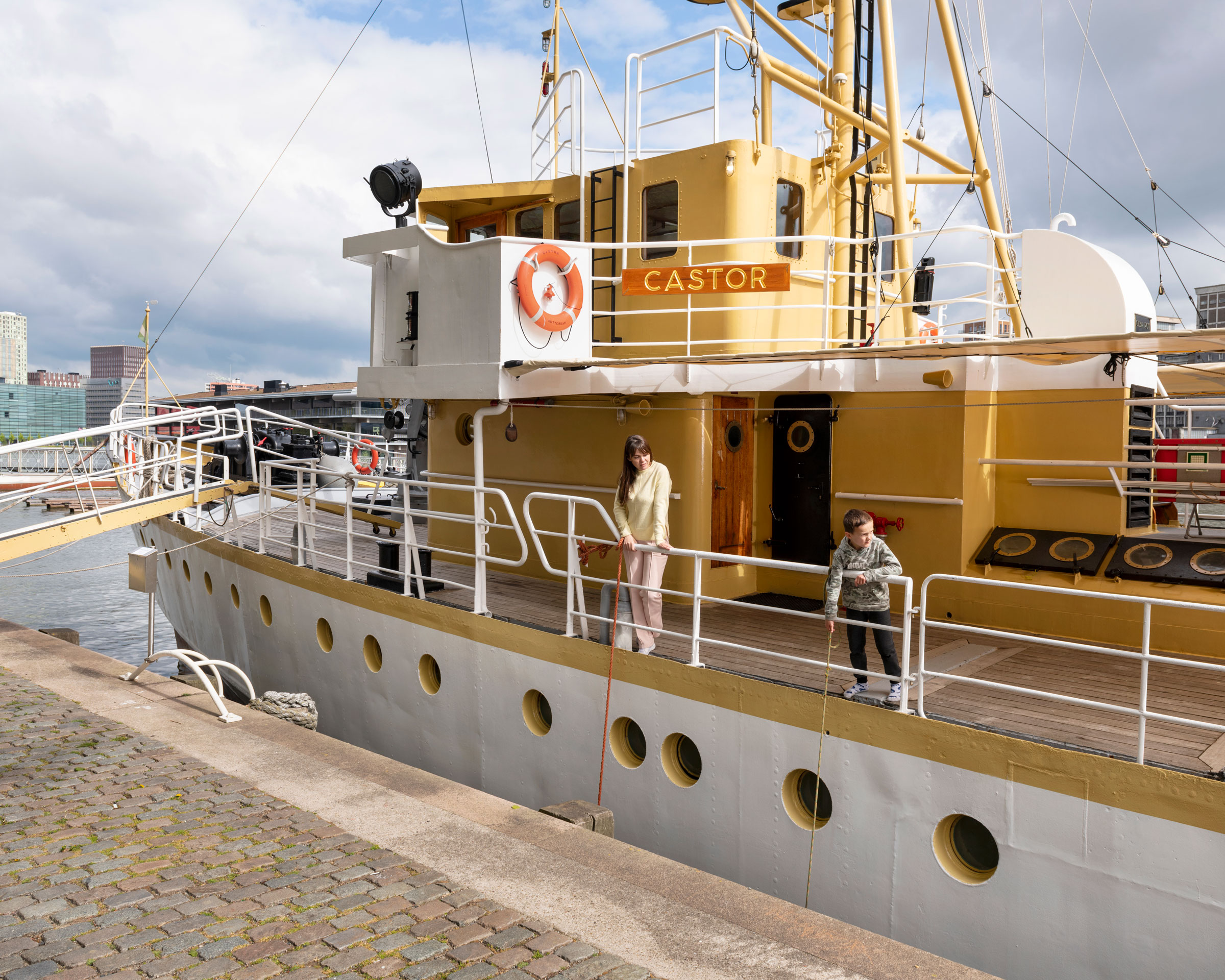Julia Martyshkina did not expect to find herself living under the sea. But when she fled Ukraine on the first day of war, she did not expect much. As the sound of explosions on Feb. 24 sent her heart racing in her chest, all she knew was that she had to grab her 8-year-old son Danilo and run.
Struggling to think clearly, she hardly packed anything. She just bundled her child on a bus that took a precarious route through the backroads of Ukraine to avoid the tortuous traffic jams on the main road to Poland. “We could see in the distance all the signs of the bombing,” says Julia, a 35-year-old baker and cake decorator from Vinnytsia. Desperate to keep her child calm, she steadied her voice and told Danilo that they were on a special trip.
“We are going to see Dad,” she reassured him.
Dad— 36-year-old Vladimir, who is separated from Julia —was at that moment in the Netherlands, nearing the end of a stint of building work. He had been due to return home to Vinnytsia, a town about 250km southwest of Kyiv, a few days later. But instead he found himself racing to Poland to reunite with his son. Three days later, he brought the whole family back to the Netherlands.
Read More: Ukrainian Refugees Try to Find Their Way in Poland
Which is how Julia, Vladimir, and Danilo found themselves living in the hull of the M.L.V Castor, a restored Cold War-era Dutch gunboat docked in the center of Rotterdam’s gleaming harbor. The re-purposing of the Castor to house 23 Ukrainians is part of efforts by the Dutch state to find beds for 50,000 Ukrainians, in a country facing its own acute housing crisis. Monasteries, holiday camps, private homes, army barracks and cruise liners—municipalities across the country have come up with their own unique solutions.
The response mirrors efforts across Europe, and demonstrates the huge logistical challenges ahead as the continent faces its biggest refugee movement since the Second World War.

More than 5.5 million people have fled Ukraine in the past few months, with most going to countries in the European Union. More than 3 million traveled to Poland, around 825,000 fled to Romania, and more than half a million are in Hungary. For the first time, the E.U. activated its Temporary Protection Directive, which means that Ukrainians arriving in an E.U. nation have the right to live, work, attend school, and travel freely to any other E.U. country.
Read More: Europe’s Embrace of Ukrainian Refugees Shows a Better Asylum System Is Possible
And while the numbers are in flux as new movements take place every day, it is clear that many people are moving on. Germany has registered 390,000 Ukrainians. Around 134,000 are in Spain. Nearly 48,000 Ukrainians have so far registered in The Netherlands, a country of 17 million people.
Julia arrived on the M.L.V Castor on March 16, assigned her berth by the Rotterdam municipality after staying for a few weeks in a cramped room where Vladimir had been doing building work. While the couple are separated, they worked together for the best interests of their child. Julia recalls her first thoughts on seeing the 150-foot gunboat, restored to its original 1947 spec including three mounted cannons. “Is it really possible to live here?” she thought as she crossed gangplank.
The family’s cabin is in the hull, below the water level. There are no portholes: just an emergency ladder leading up to the deck about 16 feet above. “The first night I could not sleep because the water was slamming on the walls,” she says. “I kept thinking, ‘I am in the water! I am under the water!’”
The ship’s owner, Mario van Parijs, says there was a similar reaction from many of the 23 people—mostly women and children—who were assigned to his ship by the Rotterdam municipality. He is bemused. He grew up on his parents’ commercial shipping vessel; living on the water is no big deal in a country with 280 miles of coastline, 3,700 miles of inland waterways, and one third of the land below sea level.
“The Ukrainian people never realized that it is also possible to live on a boat,” says the jovial Dutchman. “One family actually left in the middle of the night. They got seasick.”
The former naval engineer relishes telling the history of the M.L.V Castor, clearly aware of its contemporary resonance. It was built just after the Second World War as the Dutch prepared for the Cold War and any potential hostilities from Russia. “One of its goals was an evacuation ship for the government and the Royal Family, in case the Russians started throwing atomic bombs,” he explains.
Today, the M.L.V Castor has a new incarnation as a museum ship, party boat, and floating hotel. As one of the few sailable vessels from its era, it appeared in Christopher Nolan’s 2017 movie Dunkirk.
When the Rotterdam municipality started preparing for the arrival of Ukrainians, they knew they had to come up with innovative housing solutions. Like many countries in Europe, the Netherlands is facing a housing crisis, with nearly a million new homes needed by 2030. There are already 35,000 refugees from other countries awaiting permanent accommodation, with many living in appalling conditions in tents.
“The first option was to book a lot of hotel rooms,” Rotterdam’s Vice Mayor, Vincent Karremans, tells TIME. “We also started transforming offices that were empty. Then we started bringing them from the hotels to the river cruise ships.”

The M.L.V Castor is one of four river cruise boats that the municipality is hiring for three months to house Ukrainians. It even persuaded a cruise liner to sail one of its vessels into port, and 1,400 Ukrainians are now living aboard.
Karremans says the city’s past makes it open to those fleeing war: “Only three buildings survived the bombardment in the Second World War. It is part of our history and our DNA. We feel the fate of the Ukrainian people.”
Julia is grateful for the welcome she has received from people in Rotterdam, evidence of which is everywhere on the boat: the Officers’ Mess is littered with donated toys; tubs of toiletries brought by neighbors fill the shelves of the three bathrooms. When Julia started looking for work, the offers flooded in, and now she has three jobs: bartending, waitressing, and working in a karaoke lounge.
The municipality funds the catering aboard the Castor, and every day there is a communal breakfast and dinner, served up by Van Parijs’s wife Eelke as Ukrainian mothers dodge in and out of the galley to make meals for fussy children.
Julia is in the thick of it. She is a radiant woman, warm and effusive with a smile that makes her look a decade younger than her 35 years. She seems happy and at home on the boat, affectionately chiding the ship’s dog Butz, a heavyset brown Labrador who navigates the steep stairwells with considerable more ease than the Ukrainian children do.
But Julia is not at home, and she is not happy. Behind the smile, there are always thoughts of the war. “When I was in Poland, I saw the planes in the sky, and I thought the bombs were coming,” she says. “When I saw the birds flying above, I could not see that they were just birds.”
When she goes out to her jobs in bars and cafes, she is incredulous that people can be out having a good time, and wants to ask them what they are doing, how they can carry on.
Ira Koval, a Ukrainian woman who volunteers with the Ukrainians in the Netherlands Foundation, which existed before the war but has mobilized to help the new arrivals, says she sees the same trauma in many of her compatriots.
“Life here is like a movie which is being played to you but it is not real,” she says. “It is great weather, everything is blooming, it’s beautiful, you see people having drinks on the terraces, and you just escaped from bombings. It’s an extremely difficult situation.”
This trauma is one of the long-term issues that European nations hosting Ukrainians will have to deal with, as is education for millions of children who do not speak the language of the country in which they have sought refuge.
The immediate need, however, is housing. Julia and her family must leave the M.L.V Castor on June 16. Nobody yet knows where they will go. There seem to be few plans in place beyond the temporary solutions, but Ukrainians cannot live on boats for more than a few months, and the thousands of people across Europe who have housed Ukrainians in their own homes are starting to feel the strain. Karremans says they are working on solutions, but concedes that they have not found them yet.
It is this next phase of integrating the Ukrainian refugees that may prove the most politically testing for the European Union, and presents the possibility of tensions between the needs of the new arrivals and existing problems in their host nations. In the Netherlands, it is the balance of providing homes for Ukrainians when many Dutch people and refugees from other countries have been waiting years for stable housing. Germany is facing similar housing challenges. In Spain, the government must justify assisting Ukrainians find work when 12% of its population is unemployed. E.U. nations must find ways to navigate these delicate challenges if they are to prevent a backlash and surge in nationalist sentiment.

And while some Ukrainians are going home as the landscape of war becomes more clear, Julia cannot envisage a safe return: “Even if the war ends, the economic situation will be bad, there will be mines in the ground. Every day I will be so worried about my child.”
For now, she can only return in her dreams, and the last time her mind took her back, her homeland was a grey and desolate place. When she woke, she was overwhelmed by an unexpected emotion at her unusual situation below the waves. “I opened my eyes, I was on a ship, and I was very happy.”
More Must-Reads from TIME
- Cybersecurity Experts Are Sounding the Alarm on DOGE
- Meet the 2025 Women of the Year
- The Harsh Truth About Disability Inclusion
- Why Do More Young Adults Have Cancer?
- Colman Domingo Leads With Radical Love
- How to Get Better at Doing Things Alone
- Michelle Zauner Stares Down the Darkness
Contact us at letters@time.com
